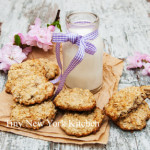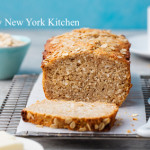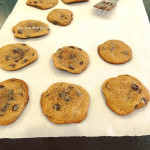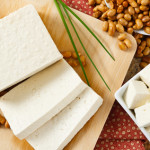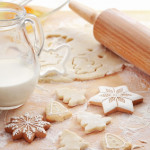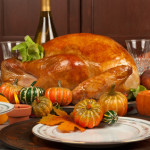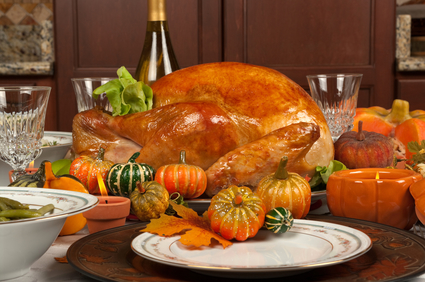Cookies
When making cookies make sure not to overcream the butter and sugar. Unlike cake batter baked in a pan, cookie dough is baked free-form. When the dough is heated and the chemical leaveners expand the air bubbles, the bubbles burst without a pan to force the dough upward, producing flat cookies. For cookies, cream the butter and sugar for only 1 to 2 minutes, just until the mixture is smooth but has not lightened in color.
Another insurance policy against flat cookies, chill butter-based cookie dough before baking. Butter has a low melting point, and starts to soften as soon as it is exposed to oven heat. Refrigerate the chilled dough for at least 30 minutes and up to 2 days before shaping and baking. This only works with dough that uses baking powder for leavening. Don’t do this with dough that includes baking soda as the leavener, which loses its rising power soon after it is mixed with wet ingredients.
Professionals use spring-loaded ice cream scoops to portion cookie dough, making cookies the same size that will bake at the same rate. A tablespoon-size scoop is the right capacity for most recipes.
For even baking and easy cleanup, bake your cookies on heavy-duty, rimmed aluminum baking sheets (half sheet pans) lined with parchment paper. To help the paper adhere, butter the baking sheet first. You can also line baking sheets with silicone baking mats instead of parchment paper.
If you’re using silicone mats, you may want to do a test run. Some cookie bottoms won’t crisp as well on the mat as they do on parchment lined baking sheets. Of course, this can be an advantage if you prefer soft, cakelike cookies.
There is no need to transfer cookies to a wire rack to cool. In fact, more harm can be done by transferring warm, delicate, pliable cookies to a rack than by letting them stand on the baking sheet. If you need to remove the cookies to use the baking sheet again, just let them cool on the sheet until they are firm enough to move.
To discourage overbrowned cookie bottoms (which can happen when an oven heats unevenly), insulate the baking sheet by placing it inside a second baking sheet of the same size. The think layer of air between the baking sheets will protect the top sheet from getting too hot.
Don’t store different types of cookies together or they will exchange flavors and textures. Tin or stainless steel covered containers work best for storage, but plastic containers can also be used as long as they are airtight and fragrance free.
To revive crisp cookies that have softened, bake them for 5 to 10 minutes in a 300 degree oven. Let them cool completely before storing.
To help soft cookies keep their texture, store them in an airtight container with a ceramic brown sugar softener, or with a piece of apple on a piece of aluminum foil, or soft bread. Make sure to remove the apple after 24 hours.
“Work With What You Got!”
© Victoria Hart Glavin Tiny New York Kitchen © 2017 All Rights Reserved
Cooking With Coffee
There’s nothing like the smell of freshly brewed morning coffee whether it’s perked, dripped or pressed, it’s the most favorite part of my day. Coffee is my morning ritual, but coffee is not just for mornings. If you have a bit of extra brewed coffee or grounds lying around then you can “perk” up the flavor of pretty much anything. The earthy flavor works in everything from meat marinades, sweet syrups, and many savory and sweet recipes using coffee as an ingredient, from tangy sauces for a tender filet mignon to a few teaspoons flavoring your favorite cakes or cookies. When added to a chocolate cake or a cookie, coffee brings out the flavor especially in chocolate. When the recipe calls for water just use what’s leftover in the pot. In many recipes you can just add a teaspoon of instant coffee or even espresso powder.
Add flavor fast to a roast by using that leftover coffee in your marinade, which also helps tenderize the meat. You can also use it to the braising liquid for beef short ribs. As the liquid cooks down, the coffee caramelized adds a delicious bittersweet dimension to the dish. I also like to stir a bit of coffee into barbecue sauce for grilled chicken or add some to homemade chili to round out the flavor.
Add coffee grounds to your spice shelf! The combination of ground coffee, kosher salt, and paprika will add flavor to your dishes. Use it to make a crusted pork or brisket dish. Rub the coffee ground spice combination to burgers before grilling them.
I like using instant espresso powder in my desserts. Unlike coffee grounds, espresso powder dissolves completely in hot water, eliminating grittiness that you may not want in most baked goods. Keep in mind that it packs a powerful punch, so a little goes a long way. Add a small amount to brownies or cakes. Freeze it with sugar for an easy granita or reduce it with sugar and cream to create a rich glaze.
“Work With What You Got!”
© Victoria Hart Glavin Tiny New York Kitchen © 2017 All Rights Reserved
Holiday Menu Ideas
Everyone who’s cooking for the holidays wonders what he or she should make for the holidays. I like to keep it simple and typically follow the “don’t experiment on your guests” rule.
Hors D’oeuvres
Mini Crab Cakes With Remoulade Sauce
Cold Seafood Platter (Lobster Tails, Jumbo Shrimp, Jumbo Lump Crab Meat)
Stuffed Mushrooms (Crab, Sausage, Cheese Stuffing)
Chicken Tenders With Honey Mustard Sauce
Chicken & Beef Satay With Asian Dipping Sauces
Jumbo Shrimp Cocktail Platter With Cocktail Sauce
Grilled Shrimp With Aioli
Mini Southwest Chicken Quesadillas With Salsa
Beef Franks In a Blanket With Whole Grain Mustard Sauce
Antipasto Platter With Imported Meats, Cheese, Peppers, And Olives
Assorted Mini Quiche
Bacon Wrapped Sea Scallops
Grilled Citrus Shrimp With Mango Aioli
Tenderloin Of Beef On Crostini With Horseradish Sauce
Salads
Mesclun Salad With Goat Cheese, Maple Candied Walnuts, Dried Cranberries And Balsamic Vinaigrette
Traditional Caesar Salad With Croutons & Shaved Parmesan Cheese
Traditional Caesar Salad With Shrimp Or Chicken
Dinner
Chicken Or Veal Marsala (Sautéed With Fresh Mushrooms & Red Roasted Peppers With Marsala Wine)
Chicken Or Veal Francese (Bathed In Light Egg Batter & Sautéed With White Wine & Lemon Sauce)
Chicken Or Veal Picata (Sautéed With Artichoke Hearts With Lemon Caper & White Wine Sauce)
Chicken Or Veal Parmigiana (Breaded & Sautéed Crispy, Topped With Marinara Sauce, Mozzarella & Parmesan Cheese)
Poached Salmon With Dijon Dill Sauce
Stuffed Filet Of Sole (Stuffed With Crabmeat & Baked With Lemon, Butter & White Wine)
Roasted Tenderloin Of Beef (Serve With Mushroom Sauce Or Creamy Horseradish Sauce & Oven Roasted Potatoes)
Roasted Turkey Breast (Serve With Traditional Stuffing, Gravy & Mashed Potatoes)
Smoked Country Ham (Serve With Roasted Sweet Potatoes & Whole Grain Mustard)
Cheese Ravioli With Marinara Or Bolognese Sauce
Manicotti Stuffed With Ricotta Cheese, Spices & Parmesan Cheese (Topped With Marinara Or Bolognese Sauce)
Stuffed Shells With Ricotta & Parmesan Cheese (Topped With Marinara Or Bolognese Sauce)
Baked Rigatoni With Herb Ricotta & Topped With Mozzarella Cheese
Classic Meat Lasagna
Vegetarian Lasagna
Flour Cheese Lasagna (Ricotta, Parmesan, Romano & Mozzarella)
Eggplant Parmigiana
Eggplant Rollatini
Sausage & Peppers In Tomato Sauce
Sausage & Broccoli Rabe Sautéed In Olive Oil & Garlic
Tuscan Sausage Cook With Broccoli Rabe & Cannelloni Beans In Creamy Tomato Sauce
Desserts
Pies
Cakes
Cookies
Zabaglione
www.tinynewyorkkitchen.com
“Work With What You Got!”
© Victoria Hart Glavin Tiny New York Kitchen
Bake Better Cookies
December is here and is cookie-baking heaven. Here are some basic tips to make a better cookie.
Split the dough. Work with half of the cookie dough at a time when rolling and cutting cookies. Too much handling of the dough makes cookies tough.
Keep the other half refrigerated since chilled dough is easier to handle.
Bake cookies on flat, shiny, heavy aluminum, baking sheets. These baking sheets with no sides are designed for easily sliding cookies onto a cooling rack. Dark sheets may absorb heat, causing cookies to brown too much on the bottom.
Grease baking sheets with cooking spray or solid shortening instead of butter or margarine.
Don’t overload the oven. Bake one sheet of cookies at a time on the middle oven rack.
Make sure to cool baking sheets between batches before reusing. Wipe the surface of each with a paper towel before reusing.
Cool cookies completely, on wire racks, before storing them in airtight containers.
“Work With What You Got!”
© Victoria Hart Glavin Tiny New York Kitchen © 2016 All Rights Reserved
Quick Breads
Quick Breads
For mouth-watering breads that don’t require a lot of time, turn to quick breads. By using baking powder, baking soda, steam, or air instead of yeast to leaven dough. An advantage of quick breads is their ability to be prepared quickly and reliably, without requiring time-consuming skilled labor and the climate control needed for traditional yeast breads. Quick breads include banana bread, beer bread, biscuits, cornbread, cookies, muffins, cakes, pancakes, brownies, scones, and soda bread.
Almost all quick breads have the same basic ingredients: Flour, leavening, eggs, fat (butter, margarine, shortening, or oil) and a liquid such as milk. Ingredients beyond these basics are added for variations of flavor and texture. The type of bread produced varies based predominantly on the method of mixing, the major flavoring, and the ratio of liquid in the batter. Some batters are thin enough to pour and others are thick enough to mold into lumps.
There are four main types of quick bread batter:
Pour Batters: Such as pancake batter, have a liquid to dry ration of about 1:1 and so pours in a steady stream – also called a “low-ratio” baked good.
Drop Batters: Such as cornbread and muffin batters, have a liquid to dry ratio of about 1:2.
Soft Doughs: Such as many chocolate chip cookie doughs, have a liquid to dry ratio of about 1:3. Soft doughs stick significantly to work surfaces.
Stiff Doughs: Such as pie crust and sugar cookie doughs, have a liquid to dry ratio of 1:8. Stiff doughs are easy to work in that they only minimally stick to work surfaces, including tools and hands – also called “high-ratio” baked goods.
Preparing a quick bread generally involves two mixing containers. On contains all dry ingredients (including chemical leavening agents or agent) and one contains all wet ingredients (possibly including liquid ingredients that are slightly acidic in order to initiate the leavening process). In some variations, the dry ingredients are in a bowl and the wet ingredients are heated sauces in a saucepan off-heat and cooled.
During the chemical leavening process, agents (one or more food-grade chemicals – usually a weak acid and a weak base) are added into the dough during mixing. These agents undergo a chemical reaction to produce carbon dioxide, which increases the baked good’s volume and produces a porous structure and lighter texture. Yeast breads often take hours to rise, and the resulting baked good’s texture can vary greatly based on external factors such as temperature and humidity. By contrast, breads made with chemical leavening agents are relatively uniform, reliable, and quick. Usually, the resulting baked good is softer and lighter than traditional yeast breads.
Chemical leavening agents include a weak base, such as baking soda (sodium bicarbonate) plus a weak acid, such as cream of tartar, lemon juice, or cultured buttermilk, to create an acid-base reaction that releases carbon dioxide. Quick bread leavened specifically with baking soda is often called “soda bread.” Baking powder contains both an acid and a base in dry powdered form, and simply needs a liquid medium in which to react. Other alternative leavening agents are egg whites mechanically beaten to form stiff peaks, as in the case of many waffle recipes, or steam, in the case of cream puffs.
There are three basic methods for making quick breads, which may combine the “rise” of the chemical leavener with advantageous “lift” from other ingredients.
The Stirring Method: Also known as the quick-bread method, blending method, or muffin method is used for pancakes, muffins, corn bread, dumplings, and fritters. This method calls for measurement of dry and wet ingredients separately, then quickly mixing the two. Often the wet ingredients include beaten eggs, which have trapped air that helps the product to rise. In these recipes, the fats are liquid, such as cooking oil. Using mixing is done using a tool with a wide head such as a spoon or spatula to prevent the dough from becoming over-beaten, which would break down the egg’s lift.
The Creaming Method: Frequently used for cake batters. The butter and sugar are “creamed” or beaten together until smooth and fluffy. Eggs and liquid flavorings are mixed in, and finally dry and liquid ingredients are added in. The creaming method combines rise gained from air bubbles in the creamed butter with the rise from the chemical leaveners. Gentle folding in of the final ingredients avoids destroying these air pockets.
The Shortening Method: Also known as the biscuit method, is used for biscuits and scones. This method cuts solid fat (whether lard, butter, or vegetable shortening) into flour and other dry ingredients using a food processor, pastry blender, or two hand-held forks. The layering from this process gives rise and adds flakiness as the fold of fat melts during baking. This technique is said to produce “shortened” cakes and breads, regardless of whether or not the chosen fat is vegetable shortening.
Quick bread originated in the United States at the end of the 18th century. Before the creation of quick bread, baked goods were leavened with either yeast or by mixing dough with eggs. The discovery of chemical leavening agents and their widespread military, commercial, and home utilization in the United States dates back to 1846 with the introduction of commercial baking soda in New York by Church and Dwight of “Arm & Hammer” fame. This development was extended in 1956 by the introduction of commercial baking powder in Massachusetts, although the best known form of baking powder is “Calumet”, which was first introduced in West Hammond and Hammond, Indiana (later Calumet City, Illinois) in 1889. Both forms of food-grade chemical leaveners are still being produced under their original names.
During the American Civil War (1861-1865) the demand for portable and quickly made food was high, while skilled labor for traditional bread making was scarce. This encouraged the adoption of bread, which was rapidly made and leavened with baking soda, instead of yeast. The shortage of chemical leaveners in the American South during the Civil War contributed to a food crisis.
As the Industrial Revolution accelerated, the marketing of mass-produced prepackaged foods was eased by the use of chemical leaveners, which could produce consistent products regardless of variations in source ingredients, time of year, geographical location, weather conditions, and many other factors that could cause problems with environmentally sensitive, temperamental yeast formulations. These factors were traded off against the loss of traditional yeast flavor, nutrition, and texture.
www.tinynewyorkkitchen.com
“Work With What You Got!”
© Victoria Hart Glavin Tiny New York Kitchen © 2016 All Rights Reserved
Sunday Baking
Baking Cookies And Listening To The Whitstein Brothers With My Kitchen Door Open. Heaven!
“Work With What You Got!”
© Victoria Hart Glavin Tiny New York Kitchen © 2016 All Rights Reserved
How To Eat More Protein On A Meat-Free Diet
How To Eat More Protein On A Meat-Free Diet
If you’re new to a meat-free diet or you struggle with ways to get the protein you need here are some important tips that may help you. It really isn’t as hard as you might think.
Snack on protein rich munchies and skip the carbs. Eat roasted chickpeas, edamame, roasted peanuts, or raw nuts. Keep away from heavily salted nuts.
If you’re looking for a frozen treat then purée coconut milk, almond butter, cashew butter, honey, and cocoa powder. Freeze in an ice cream maker for a protein rich frozen treat.
Make an easy cream sauce by whisking cashew butter with vegetable stock, garlic, and minced parsley. Toss with cooked pasta.
Crumble tempeh (fermented soybean protein) into pasta sauce or soups, or wherever you might use hamburger meat.
Purée cooked black beans and add to brownies. For blondies or light colored muffins or cakes, use cooked, puréed chickpeas.
Sprout sunflower seeds and add them to salads. Just soak raw seeds overnight in water to cover. Drain and let sprout for 24 to 48 hours.
Add ground flaxseeds to muffins, waffles, breads, or cookies for a protein boast and added omega 3 fats.
Make a protein packed pudding. Purée silken tofu with cocoa powder, honey, and vanilla extract.
Use hemp or rice protein powder instead of flour to make waffles, pancakes, and baked goods. Instead of eggs, use flax as a binder.
Lentils are awesome! Eat lentils more often. They are fast cooking and easy to use. Add to soups, toss in salads, and stir in cooked rice.
Spread sandwiches and wraps with hummus instead of mayonnaise. I do this all the time. Purée hummus with roasted red peppers or chipotle peppers for an added zing.
If you can tolerate gluten, seitan (wheat protein) is a great substitute for sliced deli meat. Use it in wraps or sandwiches for an easy lunch.
“Work With What You Got!”
© Victoria Hart Glavin Tiny New York Kitchen
Super Bowl Sunday
Super Bowl Sunday
Take a break from your new year’s resolutions and enjoy the game with great food.
Most Americans love Super Bowl parties and for many, it’s for the football and for most it’s about the commercials. But no doubt about it everyone loves the Super Bowl food.
If you’re hosting a Super Bowl party it really should be casual and low-pressure because all of the guests are supposed to be watching the game during dinner!
Here are some ideas for your Super Bowl menu. Just good old American food. Don’t worry; you can go back on your diet on Monday!
Starters
Pigs In A Blanket
Roasted Potato Skins With Sour Cream, Cheddar & Chives
Garlic Drumettes With Creamy Dill Dip Or Blue Cheese Dip
7 Layer Dip & Chips
Avocado Lime Dip
Chili Pita Chips
Crudité Tray With Onion Dip
Dinner
6 Food Sub Sandwiches
Philadelphia Cheesesteak Sandwiches
Classic Red Beans & Rice
Game Day Chili
Fried Chicken
Roasted Chicken Enchiladas
Coleslaw
Jalapeño Cornbread
Dessert
Chocolate Chip Cookies
7 Layer Bars
Everyone wins betting. Set up a pool and have everyone choose charities to put in the boxes. Make a separate pool for kids with grab bag prizes.
Mix & Match those dishes! Everything doesn’t have to match. Serve food on casual everyday dishes and if you don’t have enough of one set, just mix and match.
Most of all, don’t stress. Have a fun time and may your team win!
“Work With What You Got!”
© Victoria Hart Glavin Tiny New York Kitchen
Tips For Baking A Better Cookie
Tips For Baking A Better Cookie
After making thousands and thousands of cookies over the years one learns a few important tricks on how to make a better cookie. Here are some tips from the Tiny New York Kitchen’s kitchen.
Making Dough:
Bring butter to room temperature for 30 minutes to 1 hour before you start (unless otherwise directed). If you’re short on time, cut the butter into pieces and microwave in 5-second intervals, just until butter is soft, but not melted.
To measure flour, spoon it into your measuring cup, then level it with a knife. If you pack flour into the cup, your cookies could turn out dry and heavy.
Check the expiration dates on your baking powder and baking soda, or test the freshness by dropping a pinch into vinegar: If the baking soda or powder foams and bubbles, it’s still good.
Use pure extracts. The imitation stuff just isn’t the same.
Baking Cookies:
Buy an inexpensive oven thermometer and adjust your oven setting accordingly.
If you’re baking more than one tray of cookies at a time, switch the positions of the pans from top to bottom halfway through baking and give each pan a 180-degree turn.
Cool and quickly wash your baking sheets between batches. If you drop dough onto a hot baking sheet, the butter will start melting instantly and the cookies could lose their structure.
Line baking sheets with parchment paper for easy cleanup.
Let cookies cool for a few minutes on the baking sheets (just until they’re firm enough to move), and then remove them to a rack to cool completely (unless otherwise directed). If you leave the cookies on the pan, they could end up too crisp.
"Work With What You Got!”
© Victoria Hart Glavin Tiny New York Kitchen
Thanksgiving Menu Guide
Thanksgiving Menu Guide
In the spirit of getting organized here is a Thanksgiving Menu guide that can help you plan according. Print this list out and add your own notes. Remember that the key to a successful Thanksgiving dinner is organization.
Soups & Starters
Italian Wedding Soup (Tiny Meatballs, Tortellini & Escarole)
Creamy Mushroom Soup (Rich Mushroom Broth With Sliced Mushrooms)
Sweet Potato Kale Soup (Sweet Potatoes, Corn & Peppers Simmered in Broth, Topped With Kale)
Butternut Squash Soup (Sweet Butternut Squash Simmered in a Light Vegetable Broth With Ginger & Mace)
Chicken Stock (Chicken Bones & Fresh Vegetables Simmered For Hours)
Wild Mushroom Strudel (Portabello, Shitake & Button Mushrooms Cooked With Garlic & Herbs Finished With a Mix of Goat, Mozzarella, Gruyere & Cream Cheese Wrapped In a Crispy Puff Pastry Shell
Bacon Wrapped Scallops (Sea Scallops Wrapped in Smoked Bacon)
Sides
Garlicky Greens (Steamed Kale & Chard Seasoned with Roasted Garlic)
Roasted Brussels Sprouts (Roasted Brings Out Their Natural Sweetness)
Green Beans With Almonds (Fresh Green Beans With Sliced Crisp Almonds With a Touch of Tarragon)
Creamed Spinach With Roasted Garlic (Spinach Seasoned With Nutmeg & Tossed With Cream & Garlic)
Roasted Corn Pudding (A Savory American Classic)
Roasted Butternut Squash With Dried Cranberries (Squash, Roasted With Onions & Herbs)
Cornbread Stuffing With Sausage & Spinach (Sausage In Rustic Stuffing)
Traditional New England Stuffing (Moist Bread Stuffing With Herbs & Spices)
Classic Mashed Potatoes (Velvety Smooth Made With Cream & Butter)
Maple Bourbon Sweet Potatoes (Mashed Sweet Potatoes Sweetened With a Bourbon Maple Syrup
Home-style Green Beans (Fresh Green Beans With Cherry Tomatoes)
Apple Fennel Slaw (Granny Smith Apples, Horseradish & Fennel)
Green Salad (Mixed Green Salad With Cider Dressing)
Sweet & Sour Cabbage (Red Cabbage Braised in Duck Fat)
Peas With Pearl Onions (3 Types of Peas With Pearl Onions)
Autumn Vegetable Ragout With Soft Polenta (Vegetables & Polenta)
Roasted Beets With Orange Vinaigrette (Warm Roasted Beets With Orange Dressing)
Celery Root Salad
Warm Spinach Salad With Goat Cheese & Apples
Sweet Potato & Banana Puree
Apple Bacon Cornbread Stuffing
Mashed Potatoes And Parsnips With Crisp Root Vegetable Strips
Roasted Cauliflower And Shallots With Chard & Dukkah
Brussels Sprouts and Wheat Berry Slaw With Smoked Paprika Dressing
Rich Turkey Gravy (Smooth With Deep Roasted Flavor)
Vegan Wild Mushroom Gravy (Deep, Robust Flavor From Wild Mushrooms and a Splash of White Wine)
Organic Cranberry Orange Relish (Organic Whole Berry Relish With Orange & a Touch of Cinnamon)
Brandied Cranberry Sauce With Pecans (Whole Cranberries Cooked With Pecans, Brandy & Sugar)
Main Attraction
Organic Whole Turkey (Brined or Un-brined)
Roast Turkey With Sage Butter
Cherry Glazed Turkey
Turkey Breast
Orange Pecan Cornish Hens
Vegetarian Eggplant Parmesan
Breads
Family Style Cornbread
Parker House Rolls
Boston Brown Bread
Parmesan Garlic Biscuits
Popovers
Desserts
Pumpkin Pie
Apple Pie
Blueberry Pie
Cherry Pie
Pecan Pie
Apple Crumb Pie
Carrot Cake
Pumpkin Cake
Maple Bread Pudding
Cranberry Pear Crisp
Black Mission Fig Tart
Assorted Cookies
Make Ahead Items
Many Thanksgiving dishes or parts of dishes can be made in advance which is a big help. After writing out your menu and shopping lists look to see what can be done ahead of time.
Most soups can be made 1 or 2 days before serving.
Most appetizers (or parts of them) can be made 1 day before serving.
Roux for gravy can be made several hours before using. Just mix butter and flour together, reheat and add stock and pan drippings when time to make gravy.
Vegetables can be chopped 1 or 2 days before using.
Grate cheese or spices 1 to 2 days before using.
Wash, dry, and wrap lettuce in paper towels, and store in a ziplock bag. Place in the refrigerator until ready to toss 1 day before serving.
Most salad dressings can be made 1 to 2 days before serving.
Have turkey as prepped as possible (salted, spiced and rubbed with butter, in its pan) and ready to go in the oven.
Stuffing items such as onions, celery, mushrooms, etc can be cooked 1 day before combining with bread and stuffed into the turkey.
Bread for stuffing can be cut up the day ahead and stored in a paper bag. Dried out bread is the best for stuffing.
Desserts or parts of desserts can often be made 1 to 2 days ahead such as sauces, crusts, pie filings or toppings.
- « Previous
- 1
- 2
- 3
- Next »

